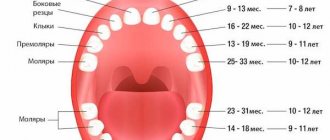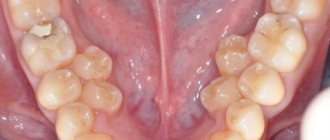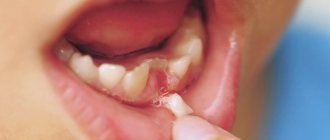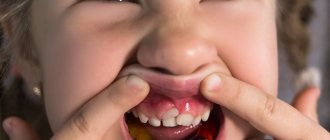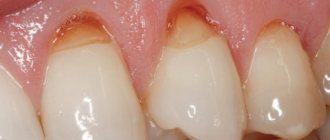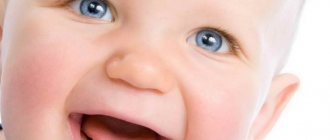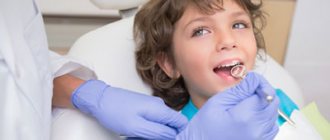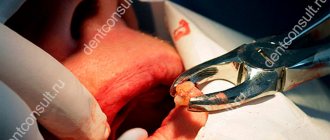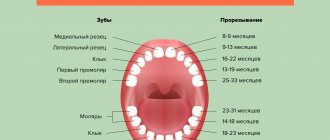No teeth at one year of age
Why does a child’s teeth not grow after a year of life?
- Hereditary predisposition.
- Unsuitable climate.
- Poor quality of food and water.
- Diseases and infections.
- Vitamin and calcium deficiency.
To dispel or confirm suspicions, you need to take your baby for examination to a therapist and dentist. To determine the causes of delayed jaw development, blood tests, urine tests, ultrasound examinations of organs, and testing of thyroid function may be necessary. To exclude edentia (lack of teeth) from the diagnostic field, fluoroscopy is performed.
How many teeth should a child have before 1 year of age?
Initial signs of teething, as a rule, appear at six months of age: active salivation, inflammation of the gums, refusal to eat. During this period, the lower incisors begin to break through, which is accompanied by swelling, diathesis, tearfulness, drowsiness, runny nose, cough, fever and even vomiting, diarrhea or constipation. Symptoms disappear 3-7 days after the exacerbation.
Eight- and nine-month-old babies grow up to six teeth. As a rule, the lower incisors are already fully formed, and the upper ones are just beginning to develop. The child learns to chew and bite food independently.
At 10-11 months, as a rule, the incisors of both rows are already formed in the mouth, and adjacent teeth are also breaking through. At this time, after eating food, it is recommended to give the baby water. To avoid caries, you should not accustom him to sweets. Maintain hygiene and cleanliness of the pacifier and spoon from which you feed your baby. If a child’s lower front tooth does not grow at this age, there is no need to panic - experts define this situation as standard and not requiring intervention. To get rid of false suspicions, you can go for a medical examination. Our VTV clinic is always happy to help with any dental problem.
Top most frequently asked questions to pediatric dentists and orthodontists
At what age should a child be shown to the dentist for the first time?
If a baby develops strong, white teeth one after another, starting from 6-8 months, then the child should be brought to the pediatric dentist at 2 years of age.
To be examined by an orthodontist at 4-5 years of age.
Why treat baby teeth?
Any tooth affected by caries is a source of chronic infection, which has a negative effect on the entire body. This chronic source of infection must be removed as soon as possible. How? The best way, if you think about the future, is to cure the tooth. The fastest way is to remove the causative tooth. If you treat a baby tooth, it will save space for the future permanent tooth and continue to take part in chewing. If a tooth is removed, there will be very little or no space left for a permanent tooth. When changing teeth, the permanent tooth will erupt as a “second row”, causing malocclusion.
If a doctor removes a baby tooth, won’t the permanent one immediately erupt in its place?
The permanent tooth will erupt when its time comes. Nature has set a strictly defined time for each tooth to appear in the oral cavity. Removing the milk precursor can speed up the process quite a bit.
Why are children's temporary prophylactic dentures made before the eruption of a permanent tooth?
If a baby tooth still had to be removed because it was too late to treat it, then you should definitely consult with an orthodontist. Nature does not tolerate emptiness and very quickly this emptiness, which formed after tooth extraction, turns into a gap due to the movement of neighboring teeth and there is simply no room left for the future permanent tooth in the dentition.
If after the removal of a baby tooth there is 1 year or more left before the permanent tooth erupts, then a plastic tooth is made that will save space for the permanent tooth. This is a children's prosthetic prosthesis.
Are there really teeth that come out immediately permanent, without milk predecessors?
Yes, everyone knows the sixth, seventh and eighth (“wisdom”) teeth, if you count from the first central tooth in each direction. Immediately permanent, without milk precursors, the following appear: the 6th tooth (at 5-6 years), the 7th (at 11-12 years), and the wisdom tooth after 16 years.
At what age is it most effective to install braces?
The ideal age for installing braces is 9-11 years old. At this age, due to the growth of the jaw, the absence of the 7th teeth and the opportunity to teach the child to take good care of the braces system, the orthodontist has a good chance of completing the treatment “without tooth extraction,” straightening the teeth and even completely correcting the bite. Also, treatment at this age has the most favorable prognosis regarding the stability of the result obtained.
What to do if a child has “weak” enamel and uneven teeth?
If the situation is critical, the bite is severely disturbed, or the child does not smile due to crooked teeth, and the enamel is significantly weakened, we suggest installing a brace system on the tongue side. But not a classic lingual brace system, which will constantly come off for a child and impair diction, but an INCOGNITO brace system with wide bases, individually manufactured for each of your child’s teeth in a laboratory in Germany.
Fissure sealing – what is actually being sealed?
Many parents have a negative attitude towards this procedure, believing that caries occurs under the sealant (special varnish). Given the technology, this is not the case. After cleaning the tooth with a special paste using ultrasound, the doctor applies a thin layer of fluoride varnish, which smoothes out the deep anatomical pits and grooves (fissures) on the tooth. If sealing is not done, then over time an invisible white coating accumulates in the fissures, containing microorganisms that, in the course of their vital activity, release acids and the tooth enamel begins to gradually dissolve, caries appears in the “white spot” stage, which is not visible to the eye. And when the coloring of this caries with pigments appears and it becomes noticeable, the caries already affects the entire thickness of the enamel. The sooner you contact a pediatric dentist, the greater the chance that there is no caries in the fissure in the form of a “white spot.” The doctor can easily check this by staining the chewing surface of the tooth with a caries marker before sealing.
What does it mean if all your teeth have been replaced, but one or two baby teeth still won’t fall out?
This means that the permanent tooth is “stuck” somewhere in the bone tissue and needs to be pulled into place. There may be another situation - the germ of a permanent tooth has not formed. In both cases, you should definitely consult an orthodontist.
If an X-ray of a 12-year-old child does not show the germ of a permanent tooth, can it appear later?
No, he can not. If the tooth germ is absent on the x-ray, and therefore in the bone tissue, it will never appear again and this permanent tooth will be absent from the oral cavity. The exception is wisdom teeth.
When and where to “cut” the frenulum, in the maternity hospital or in dentistry?
In the maternity hospital, the frenulum of the tongue is cut when the child cannot perform sucking movements due to the low mobility of the tongue, which is restrained by this very frenulum.
The frenulums of the upper and lower lips, in the case of a gap between the central teeth (diastema), are trimmed (in these cases, it would be more correct to say frenuloplasty) not earlier than the permanent incisors, second from the center, begin to erupt. Such plastic surgery can be performed correctly by a doctor who knows a special technique, which subsequently helps to close the diastema. Plastic surgery of the frenulum of the upper and lower lips is done only in the direction and under the supervision of an orthodontist, otherwise the diastema may persist.
What does it mean if a child has snow-white spots and stripes on his permanent teeth that were not there before?
This means that the child is not cleaning the surface of the tooth enamel properly. This may be a lack of knowledge of teeth brushing techniques or a toothbrush that is too soft. Or – lack of regular teeth brushing as such. A thin, dense layer of plaque that has accumulated over weeks and months on the surface of the tooth dissolves the enamel and it begins to turn white (demineralize).
Why wear trainers and plates when you can get braces right away?
Trainers, like plates, are effective at a certain age as the child grows. It is at this age that jaw growth can be directed in the desired direction, and the braces system can be installed early. Braces are installed at a later age to completely straighten the teeth.
Why do children need to be treated by a special dentist – a pediatric dentist?
Milk teeth are very different from permanent teeth, but their main feature is the location of the “nerve” close to the surface of the tooth, absorbable roots and the proximity of the permanent tooth germ. Children's permanent teeth also have a number of features, the most important of which are immature enamel and developing (growing) roots. Only a dentist with special education knows how to treat children’s teeth.
What to do if the baby tooth has not yet fallen out, but the permanent one is trying to erupt nearby?
It is necessary to contact a pediatric dentist as soon as possible to remove a baby tooth to make room for a permanent tooth. If a baby tooth is removed on time, there is a chance that the permanent tooth will erupt smoothly.
Is it normal that at the age of 5 – 7 years a child develops gaps between his milk teeth, which were previously tightly spaced?
This is how nature intended. Before changing teeth, the child’s jaws begin to grow, the size of the baby teeth does not change, and this contributes to the appearance of gaps that will be needed to accommodate future permanent teeth.
If gaps do not appear at this age, it means something has gone wrong and you should consult an orthodontist.
Anna Redko, chief physician of the Russian-German network of dentists “Clinic of Doctor Lange”.
Over 1 year old
At one year of age, children, as a rule, already have eight full milk teeth in their mouths. This age limit is the optimal time to visit the dentist. The doctor will evaluate the condition of the oral cavity and help prevent problems.
At the age of 1.5-2 years, a child can have from 4 to 14 teeth. We must begin to accustom him to oral hygiene, showing him how cleaning is done by example. By the age of 2.5 years, children, as a rule, acquire two dozen milk teeth, which serve them until the age of 5-6 years. A visit to the dentist or orthodontist may be necessary if:
- premature development of the jaws, which is facilitated by endocrine dysfunction;
- growth retardation, often caused by rickets, digestive problems, infections and genetic inheritance;
- incorrect position of the incisors, indicating deeper bone disorders.
Until the age of six, the number of teeth remains the same - about 20. At this time, you need to continue to develop in the child a love of oral hygiene, wean him from finger sucking and nail biting.
The first replacement of baby teeth with molars begins at 6-8 years of age. By the age of 14-15, the jaws are completely renewed.
How to prevent caries in one-year-old children: preventive measures
Simple preventive measures will help prevent the development of this pathology, which can lead to the loss of several baby teeth at once:
- Clean your baby's teeth and gums with a special fingertip immediately after eating.
- Do not bottle feed a 1 year old child.
- Dentists note that bottle caries can also develop in one-year-old breastfed children. What's more, breast milk contains more sugar than formula, so prolonged breastfeeding can be damaging to children's teeth.
- Brush your teeth immediately after teething. First, use a soft toothbrush with fluoride-free toothpaste; after two years, you can use baby toothpaste with fluoride.
- Brush your child's teeth or supervise this process until he is at least eight years old.
- Don’t give sweet drinks, it’s better to teach them to drink plain water and unsweetened tea.
- Do not feed your baby at night. At night, the production of saliva, which has a bactericidal effect and fights germs, decreases. If necessary, you can give your child clean water to drink at night.
- Do not share a spoon with your child or put his pacifier in his mouth to avoid the transmission of cariogenic bacteria.
- Check your teeth regularly. If you notice white spots on them, lines on the tooth enamel near the gums, be sure to contact your dentist.
- Visit your dentist regularly, even if there are no stains on your teeth.
Follow all preventive measures, and you can prevent caries in children under one year old and maintain oral health.
What to do to ensure that your child’s teeth develop normally
Before and during pregnancy:
- Maintain dental health.
- Eat well and varied.
- Eat more foods high in calcium.
- Do not smoke or drink alcohol.
- Walk in the fresh air more often to maintain a healthy level of hemoglobin in the blood.
- Treat in strict accordance with medical recommendations.
After childbirth:
- provide the child with a rich and balanced diet;
- monitor the baby’s hygiene;
- walk in the fresh air to harden the child’s body;
- prevent infection and diseases of internal organs;
- Consult a doctor in a timely manner in case of painful syndromes.
In what cases can a child grow a second row of baby teeth?
The rudiments of baby teeth are formed very early, even before the baby is born, so disturbances in their growth are a consequence of the lack of space in the jaw to accommodate all the teeth.
What can lead to improper formation of buds or insufficient jaw size?
- Poor nutrition of a woman during pregnancy. For the proper formation of the baby’s body, including his future teeth, it is necessary that the mother receives vitamins and minerals in the quantities that she and the child need. If there are not enough of them, then the deficiency can lead to disruption or slowdown in the growth of both the rudiments of future teeth and the jaw bone.
- Lack of calcium and fluoride as the main elements for maintaining dental health in a child’s diet. It is necessary to carefully monitor how the baby eats so that the peculiarities of food do not become a problem for him and his teeth in the future.
- Avoiding solid foods in the infant's diet. Gnawing on harder foods is a necessary action that helps to properly position the erupting baby teeth in the jaw. If the baby receives only soft or liquid food, then he does not have the opportunity to correctly identify the places for all the baby teeth.
- Genetic predisposition to problematic growth of baby teeth. Unfortunately, genetics also influences crooked teeth. But don’t worry, because modern pediatric dentistry offers many ways to correct a child’s bite without much worry for both him and his parents.
Teeth are growing incorrectly - can this be corrected?
Of course, there are ways to correct irregularities in the growth of both baby and permanent teeth, including the growth of their second row in a child. You can often hear a myth that the incorrect growth of temporary teeth does not need to be corrected, because with age they are still replaced by permanent ones. This is a fundamentally wrong approach. In addition to the child developing complexes and frequent pain from malocclusion, curvature of baby teeth can lead to growth disturbances in permanent teeth, which is much more difficult to correct.
However, if permanent teeth require correction, then this is also not a reason to be too upset: orthodontists can recommend a lot of ways to correct abnormal growth of permanent teeth (aligners, trainers, braces).
Braces are placed at older ages - teenagers or adults. Since at this time the roots of permanent teeth are already formed, correction takes much longer than if it began in childhood. Often, wearing braces lasts for a year and a half, and sometimes for longer.
Whereas a doctor may prescribe a mouthguard or trainer for a child. In general, when correcting a bite, the rule is true: the sooner the better, which should always be kept in mind when detecting any problems with the arrangement of teeth in the jaw.
Of course, during the correction it is also necessary to maintain careful oral hygiene. Correction systems in the mouth can trap pieces of food, which subsequently become a good environment for microorganisms. This can lead to problems with the enamel, and in the longer term, even to caries and tooth decay.
Therefore, Asepta recommends using products to ensure oral hygiene. We have developed toothpastes specifically for children - they carefully clean, protect enamel from caries, and saturate it with minerals. Pastes also help get rid of food debris and prevent the proliferation of microorganisms on the teeth while wearing correction systems, and the antiseptic component in their composition helps disinfect the oral cavity.
What to do if a child’s tooth grows in the second row?
Sometimes such teeth sit so tightly in the gums that only their surgical removal can solve the problem. If precious time was missed, during which it was possible to easily return the permanent teeth to their place or allow them to erupt correctly, then retention may occur. Retention is the incomplete eruption of a tooth, in which it remains a small part inside the gum or, conversely, is almost completely hidden in it. It is much more difficult to correct than correcting abnormally growing permanent teeth. Therefore, it is worth paying attention to problems with a child’s bite as early as possible, even before his temporary teeth begin to change to permanent ones.
Only a dentist can make any decision regarding an impacted tooth and only after a complete examination of the small patient’s jaw. To do this, a complete photograph of the jaw is taken, which clearly shows the location of the tooth and possible paths of development of events. Next, the doctor may resort to either making an incision in the gum, followed by installing a brace system on the teeth, or removing the tooth, if nothing can be done to help. The latter, however, rarely happens. More often than not, doctors try to find a way out of any situation, and braces systems currently make it possible to solve almost any problem with an impacted tooth.
Therefore, if you notice that your child is growing second row of milk or permanent teeth, you should not panic, but you should not lose sight of the situation either. Make an appointment with a doctor and get examined. The dentist will assess the situation and offer the best approach to solving the problem. Early contact with a doctor is the key to quick treatment.
Take care of the health of your loved ones with Asepta!
If a new tooth does not grow in place of a baby tooth
The loss of baby teeth, as well as their appearance, does not occur simultaneously, but in accordance with the development of the jaws and the growth of permanent replacement. The concept of a protracted renewal is quite relative, because for some the radical will show itself in a week, and for others in a month or two. And in the second case, we are not always talking about deviation.
Often baby teeth are “pushed out” by molars, which almost immediately make their way out, but if a child’s tooth falls out and a new one does not grow and is not visible, you need to wait a few weeks.
Reasons to see a doctor:
- lack of replacement 2-3 months after the loss of a baby tooth;
- swelling and redness of the gums, pain without signs of germination of a molar;
- sequential loss of other teeth without the appearance of new ones.
Reasons why a child’s tooth does not grow for a long time:
- Infectious diseases, including past ones.
- Lack of calcium in the body.
- Oral diseases.
- Mechanical injuries.
A child’s tooth has fallen out and is not growing, but the situation does not correspond to the reasons indicated? Perhaps the delay is provoked by poor ecology, incorrect or poor-quality diet, stressful situations, or even genetic preconditions.
Approximate timing of baby teeth eruption
On average, the first tooth appears at 6-7 months, but sometimes this joyful event occurs earlier - at 4-5 months, or, on the contrary, is delayed. The reason for this, as a rule, is heredity. Therefore, you should not unconditionally rely on generally accepted charts: everything is individual.
In general, the monthly scheme looks like this:
- 6-7 months - most babies have 2 lower incisors in the center;
- 8-9 months – by this age you can expect 2 upper incisors;
- 9-11 months – by almost a year, 2 lateral incisors are visible from above;
- 12-13 months - during this period there are also 2 lateral incisors from below.
So, to the question of how many baby teeth a child should have by the age of one year, we can safely answer: 8.
Pathological causes of delay
If a child’s teeth have fallen out and new molars do not grow for a long time, the reasons for the delay should be sought in pathologies:
- Retention is a complete or partial delay in eruption. Partial retention is observed when the crown of a molar tooth appears in the socket of a milk tooth, but growth stops there. Often the cause is early loss of a baby tooth, accidental or surgical. That is, a replacement for him has not yet been formed.
- Adentia – absence of teeth. This rare problem is common in older people, but can also occur in children. As a rule, it is triggered by taking strong medications during pregnancy.
Features of bottle caries
Bottle caries in a child under 1 year of age is one of the most common types of carious lesions in primary teeth. It occurs when young children are bottle-fed before bed. As a result, food remains in the oral cavity, which bacteria actively process while the child sleeps.
There is a myth that bottle caries cannot occur if the child is fed natural products - milk, kefir, juice without sugar. But cariogenic bacteria feed not only on artificial, but also on “natural” sugars - lactose, fructose, so the “naturalness” of children’s products does not reduce the risk of developing bottle caries.
Recommendations for avoiding delay
- After tooth loss, you should not eat or drink hot drinks for several hours.
- The plug that forms in the hole cannot be removed to avoid infection. It will disappear on its own.
- It is not advisable to eat solid food for the first time after the loss.
- If you experience pain, redness, swelling or other signs of exacerbation, you should immediately contact your dentist. Remember, our specialists are always ready to help and answer your questions by phone.

